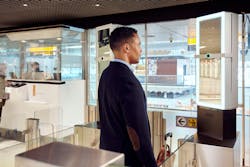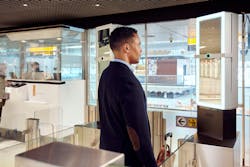Methods for improving airport security and travel experience with iris recognition
Airports around the globe and domestically within the United States are charged with the daunting task of keeping employees and travelers safe. In addition to providing error-free security, this service should be fast and airport employees courteous. Even before the start of the Covid-19 pandemic two years ago, when flights were full and demand exceeded service, airport executives recognized the need to plan for the future to improve the traveler’s airport experience by repairing infrastructure and instituting innovative programs that would speed airport check-in, offer perks and require less input from the customer. Examples of how some airports such as Hamad International Airport (HIA), Schiphol Airport and the Canadian Air Transport Security Authority (CATSA) have answered the need for better security include adopting biometrics technologies. Private companies such as CLEAR have also ventured into providing a biometric authentication solution to offer a faster more secure way to check in at the airport or an entertainment venue. Admittedly, Airport operations are difficult; it must balance the need for efficiency, customer service, and security. Iris technology is one solution that can meet this need and grow with the industry to help influence the future of air travel.
Meeting Today’s Aviation Demands
The demand for air travel is back to pre-pandemic levels, leading to longer lines at security checkpoints and increased wait times. To prevent missed flights, the TSA currently advises travelers to arrive at the airport two hours before their flight for domestic travel and three hours prior to international travel. This recommendation is in direct contrast to what travelers really want. The International Air Transport Association (IATA) reported in its 2021 Global Passenger Survey that 85% of air passengers want to spend less than 45 minutes in the airport when traveling with only carry-on luggage. Those traveling with a checked bag wish to spend no more than an hour.Such an obvious disconnect between customer wants and reality only highlights the need for an increase in passenger throughput. Unfortunately, airport facility management teams already have a significant number of challenges to deal with on top of assuaging travelers.
The security requirements for an airport are unmatched in both complexity and oversight. Not only are facilities responsible for overseeing passenger safety, but also the management of employees and third-party workers. Management teams are therefore tasked with maintaining all secure environments with accurate identity authentication and verification while simultaneously delivering a high level of customer satisfaction.
This duality of high security and high service has created significant operational gaps in the airport environment that requires innovative process reengineering and comprehensive operational improvements to repair. Iris recognition technology has provided a touchless and advanced identity authentication solution used at self-security e-gates, kiosks and immigration and border control lanes. This biometric solution allows passengers to quickly clear security checkpoints in less than 10 seconds marrying the need for top-notch security, fast throughput, and a seamless travel experience.
Why Iris Recognition
Iris recognition provides a viable solution for both air travelers and airport security professionals. It ensures fast throughput at security checkpoints by employing the most secure and accurate form of non-invasive biometric authentication. The iris alone has 240 recognition points – far more than fingerprint and facial technologies. Moreso, every person’s iris is unique, leading to fewer false positives and absolutely no opportunity for bias. And unlike ID cards and passports, a distinctive iris pattern is not susceptible to theft, loss, or compromise. This makes iris recognition technology highly reliable and uniquely suited to authenticate and verify identities accurately.
In an airport operation, iris recognition’s unique capabilities are also proven to increase security, speed, and user satisfaction when used for personal identification. Full enrollment with instruction can take less than 2 minutes. There is no invasive scanning while subjects stand up to a meter away from scanners. Iris recognition uses camera-like technology to take a picture of the iris, creating digital templates using encoded algorithms to form a unique value only matched to one person. Once enrolled, authenticating an individual takes less than 2 seconds and allows for an entirely touchless access control experience.
Making security check-in faster, frictionless, and more secure presents a win-win for both travelers and those responsible for airport operations. The same also holds true for personnel needing access to secured areas. This includes third-party contracted workers who frequent aviation facilities with deliveries and provide vendor services. The ability to closely monitor all personnel who gain access to secured areas is as important as keeping the general public out. Iris recognition can control access to these sensitive areas of an airport’s operation and enables airline personnel and vendors to be easily identified and granted access to appropriate areas.
The application of iris recognition technology within an airport environment, whether customer or employee-facing, offers numerous benefits to airport operations. For example, self-service biometric kiosks of e-gates remove the need for manual passport checks. Low-risk travelers can move through security checkpoints quickly while officials are able to focus more attention on unknown travelers. Saved labor resources can now be redistributed throughout the airport to address additional operational or security processes. Furthermore, with more time saved at security, passengers can spend more time taking in the airport’s offerings or lounging, thus improving their travel experience.
Millions of passengers every year use the biometric-enabled immigration counter e-gates at Hamad International Airport in Doha, Qatar. The International Civil Aviation Organization has praised the Hamad International e-gate program as a model system that can be applied by other countries. To expand upon this success, the same iris recognition technology found at immigration counters and e-gates has been deployed to over 500 border crossing points in Qatar. These solutions will also be used to process an estimated 3 million visitors’ identities in the lead-up to the 2022 FIFA World Cup.
Beyond Qatar, iris recognition is already being adopted worldwide to process trusted travelers simply, quickly, and securely. CLEAR, a New York-based private company, employs iris authentication software and cameras embedded in kiosks to identify vetted travelers in more than 40 major U.S. airports. Amsterdam's Schiphol Airport similarly operates its Privium program using iris recognition technology, which enables Dutch citizens and travelers to clear immigration and customs in 15 seconds or less. This same technology is extended to manage access to the airport’s three lounges, all exclusive to members of the Privium program.
In 2004, the Canadian Air Transport Security Authority (CATSA) deployed a unique iris recognition system for use exclusively by employees. Each CATSA employee’s iris biometric is enrolled and stored on a smartcard, which is used to gain access to secured areas both landside and airside. Iris recognition technology is integrated with the existing physical access control systems installed at each of the 41 individual CATSA airports. An estimated 200,000 employees have already participated in this program, proving that the application of biometrics for physical security within aviation goes beyond that of passenger facing. By storing iris data on the smartcard CATSA addresses any privacy concerns and comply with recent GDPR regulations.
Iris recognition technology provides a complete solution for accurate authentication for security and access control. The key to more wide-scale adoption is education about the convenience of the technology and more communication about current usage. In IATA’s 2021 Global Passenger Survey, 73% of passengers were willing to share their biometric data to improve airport processes, up from 46% in 2019. Airline customers have already proven the convenience of digitized solutions is appealing. Passengers can book a flight, pick seats, receive flight update notifications, and download a digital boarding pass through airline apps. It is this ease of use that passengers wish to see replace the time-consuming, repetitive security processes they experience upon arrival. If consumers and security administrators are kept abreast of the technology and its benefits, predicting mass adoption and biometric program opt-ins is reasonable. Mass educational marketing, visible signage, and announcements where biometrics are deployed will certainly help.
Airports of the Future
Twentieth-century air transportation infrastructures are already strained under the demands of 21st-century airport operations and a waning global pandemic. In this volatile business environment, airports the world over are confronting extraordinary challenges including the inherent contradiction between improving operational efficiency, customer service, and the overall travel experience while combating a broad range of security threats. Iris recognition has proven itself an effective and preferred authentication method for meeting these challenges in a 21st-century world – a world where consumers do not like to wait and demand things now, but also want their security all but promised. As this technology evolves, and product and deployment costs decline, iris recognition technology stands to be the preeminent biometric for airport security.
About the Author

Mohammed Murad
Vice President, Global Development and Sales, Iris ID
Mohammed Murad is VP of global sales and business development for Iris ID. Request more info about the company at www.securityinfowatch.com/10406656.



